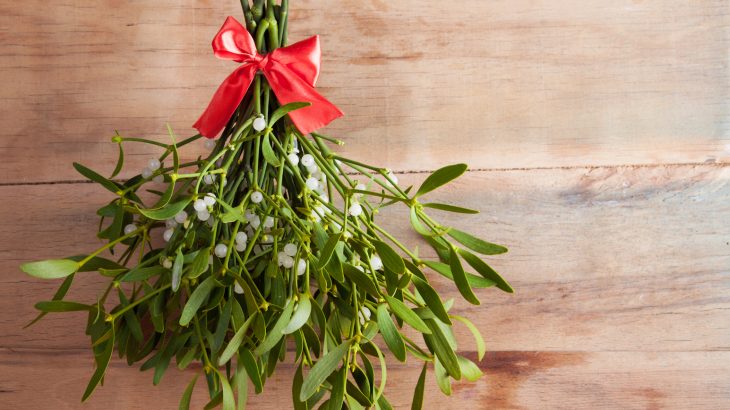Mistletoe is the festive plant – a symbol of renewal because it stays green all winter. The tradition of hanging it in the house goes back to the times of the ancient Druids.
It is supposed to possess mystical powers which bring good luck to the household and wards off evil spirits. It was also used as a sign of love and friendship in Norse mythology and that’s where the custom of kissing under Mistletoe comes from.
The custom of kissing under Mistletoe comes from England. The original custom was that a berry was picked from the sprig of Mistletoe before the person could be kissed and when all the berries had gone, there could be no more kissing!
Here are some mistletoe facts that you may have never heard before:
1.There are 1,300 species worldwide. The continental United States and Canada are home to more than 30 species, and Hawaii harbors another six. Globally, more than 20 mistletoe species are endangered.
2. European mistletoe grows in temperate regions all over the world. There are also several species in America that thrive in the deserts in the Southwest, where they live on palo verde, mesquite, juniper, pine and other trees.
3. All mistletoes grow as parasites on the branches of trees and shrubs. The genus name of North America’s oak mistletoe—by far the most common species in the eastern United States—is Phoradendron, Greek for “tree thief.”
4. Ancient Anglo-Saxons noticed that mistletoe often grows where birds leave droppings, which is how mistletoe got its name: In Anglo-Saxon, “mistel” means “dung” and “tan” means “twig,” hence, “dung-on-a-twig.”
5. Mistletoes produce white berries, each containing one sticky seed that can attach to birds and mammals for a ride to new growing sites. The ripe white berries of dwarf mistletoe, native to the western United States and Canada, also can explode, ejecting seeds at an initial average speed of 60 miles per hour and scattering them as far as 50 feet. When a mistletoe seed lands on a suitable host, it sends out roots that penetrate the tree and draw on its nutrients and water. Mistletoes also can produce energy through photosynthesis in their green leaves.
6. Unlike many plants which are both male and female, mistletoe is in a group of plants that are dioecious. This means that plants are either male or female. It is the female plants that have the white berries.
7. As they mature, mistletoes grow into thick, often rounded masses of branches and stems until they look like baskets, sometimes called “witches’ brooms,” which can reach 5-feet wide and weigh 50 pounds.
8. Trees infested with mistletoe die early because of the parasitic growth, producing dead trees useful to nesting birds and mammals. A mistletoe-infested forest may produce three times more cavity-nesting birds than a forest lacking mistletoe.

9. A variety of birds nest directly in witches’ brooms, including house wrens, chickadees, mourning doves and pygmy nuthatches. Researchers found that 43 percent of spotted owl nests in one forest were associated with witches’ brooms and that 64 percent of all Cooper’s hawk nests in northeastern Oregon were in mistletoe. Several tree squirrel species also nest in witches’ brooms.
10. Three kinds of U.S. butterflies depend on mistletoe for survival: the great purple hairstreak, the thicket hairstreak and the Johnson’s hairstreak. These butterflies lay eggs on mistletoe, and their young eat the leaves. The adults of all three species feed on mistletoe nectar, as do some species of native bees.
11. The mistletoe’s white berries are toxic to humans but are favored during autumn and winter by mammals ranging from deer and elk to squirrels, chipmunks and porcupines. Many bird species, such as robins, chickadees, bluebirds, and mourning doves, also eat the berries.
12. It goes by many different names – birdlime, all-heal, golden bough, drudenfuss, iscador and devil’s fuge.

The type of mistletoe most people think of during the holidays is Phoradendron serotinum. It is commercially harvested and sold around the world. This species typically grows on oak trees across North America, and is native to Mexico.
Sources:

